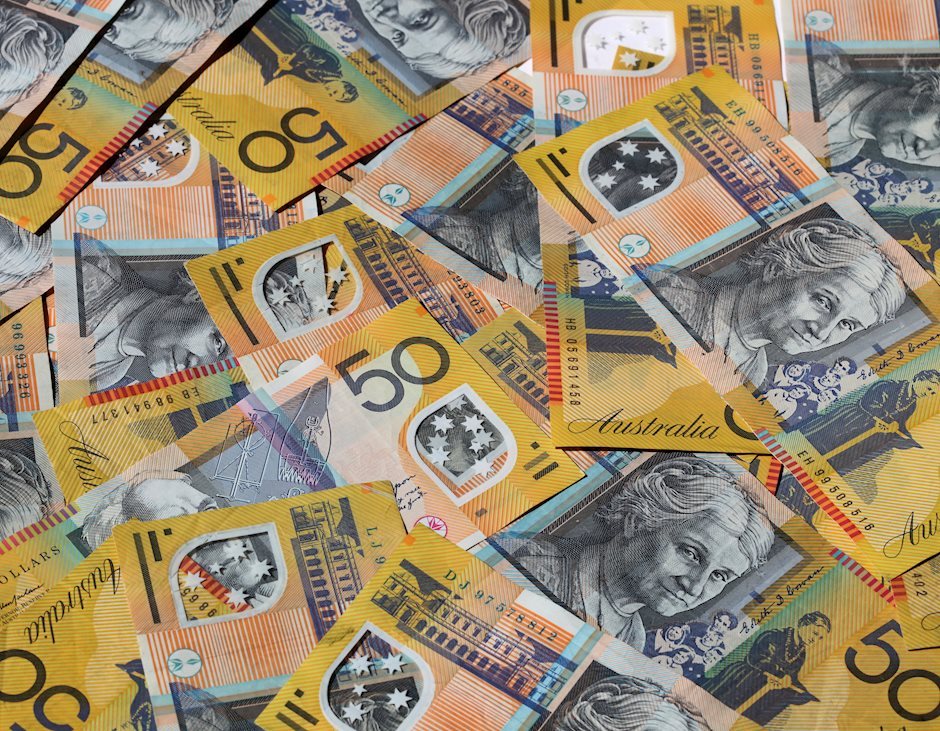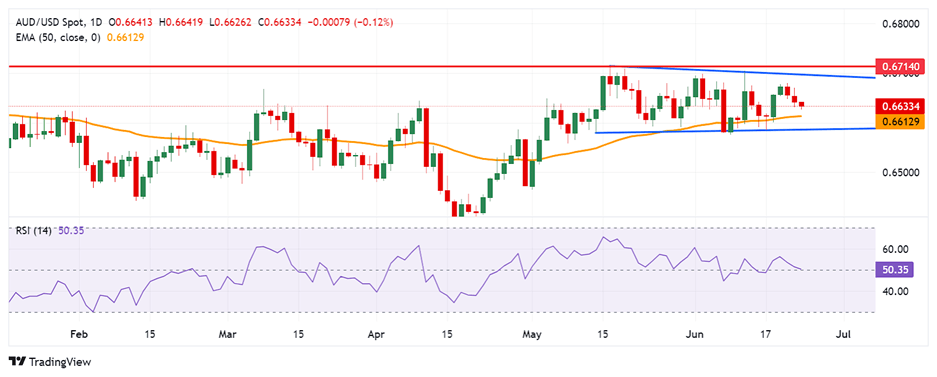Australian Dollar gains ground, while US Dollar struggles due to lower yields
- The Australian Dollar recovered its daily losses as the US Dollar declined due to lower US yields.
- The Aussie Dollar receives support from the RBA’s hawkish stance on interest rate trajectory.
- The US Dollar may limit its downside as Fed officials delay the timing of the first interest rate cut in 2024.

The Australian Dollar (AUD) recovers its intraday losses as the US Dollar (USD) depreciates due to the decline in the yields on US Treasury bonds on Monday. The upside in the AUD/USD pair could be reinforced by the hawkish stance of the Reserve Bank of Australia (RBA). The RBA Governor Michele Bullock said during her latest press conference that the Board discussed potential rate hikes, dismissing considerations of rate cuts in the near term, as per ABC News.
The US Dollar may limit its downside as the higher-than-expected US Purchasing Managers Index (PMI) from Friday boosted the speculation of delaying the expected timing of the first interest rate cut this year. According to the CME FedWatch Tool, investors are pricing in nearly 65.9% odds of a Fed rate cut in September, compared to 70.2% a week earlier.
Daily Digest Market Movers: Australian Dollar declines due to hawkish Fed
- The ASX 200 Index fell below 7,750 on Monday, relinquishing some of the gains from the previous session. This decline follows a weak lead from Wall Street, where Nvidia and other artificial intelligence-related chip stocks faced heavy selling after a strong run.
- The People's Bank of China injected 50 billion Yuan via seven-day reverse repos, maintaining the reverse repo rate at 1.8%. Any change in the Chinese economy could impact the Australian market, as China and Australia are close trade partners.
- Investors are likely to be cautious ahead of this week's Australian inflation data. Markets have significantly reduced their expectations for a RBA’s rate cut this year, with an easing not anticipated until April next year.
- On Friday, the US Composite PMI for June surpassed expectations, rising to 54.6 from May’s reading of 54.5. This figure marked the highest level since April 2022. The Manufacturing PMI increased to a reading of 51.7 from a 51.3 figure, exceeding the forecast of 51.0. Similarly, the Services PMI rose to 55.1 from 54.8 in May, beating the consensus estimate of 53.7.
- As per a Reuters report, Fed Reserve Bank of Minneapolis President Neel Kashkari noted on Thursday that it will probably take a year or two to get inflation back to 2%.
Technical Analysis: Australian Dollar remains below 0.6650
The Australian Dollar trades around 0.6630 on Monday. Analysis of the daily chart shows a neutral bias for the AUD/USD pair as it consolidates within a rectangle formation. The 14-day Relative Strength Index (RSI) is positioned on the 50 level, further movement may give a clear directional trend.
The AUD/USD pair may find support around the 50-day Exponential Moving Average (EMA) at 0.6612, with additional support at approximately 0.6585, marking the lower boundary of a rectangle formation.
On the upside, the AUD/USD pair may encounter resistance near the upper boundary of the rectangle formation around 0.6700. Beyond that, potential resistance levels include the high of 0.6714 observed since January.
AUD/USD: Daily Chart
Australian Dollar price today
The table below shows the percentage change of the Australian Dollar (AUD) against listed major currencies today. The Australian Dollar was the strongest against the US Dollar.
| USD | EUR | GBP | CAD | AUD | JPY | NZD | CHF | |
| USD | -0.27% | -0.18% | -0.19% | -0.31% | -0.06% | -0.28% | -0.05% | |
| EUR | 0.25% | 0.08% | 0.08% | -0.03% | 0.20% | -0.02% | 0.20% | |
| GBP | 0.18% | -0.08% | -0.02% | -0.11% | 0.12% | -0.10% | 0.13% | |
| CAD | 0.19% | -0.08% | 0.01% | -0.09% | 0.13% | -0.10% | 0.14% | |
| AUD | 0.31% | 0.02% | 0.10% | 0.08% | 0.23% | 0.00% | 0.27% | |
| JPY | 0.06% | -0.19% | -0.12% | -0.12% | -0.23% | -0.21% | 0.03% | |
| NZD | 0.28% | 0.01% | 0.10% | 0.10% | -0.01% | 0.22% | 0.24% | |
| CHF | 0.06% | -0.21% | -0.13% | -0.14% | -0.24% | 0.00% | -0.24% |
The heat map shows percentage changes of major currencies against each other. The base currency is picked from the left column, while the quote currency is picked from the top row. For example, if you pick the Euro from the left column and move along the horizontal line to the Japanese Yen, the percentage change displayed in the box will represent EUR (base)/JPY (quote).
Australian Dollar FAQs
One of the most significant factors for the Australian Dollar (AUD) is the level of interest rates set by the Reserve Bank of Australia (RBA). Because Australia is a resource-rich country another key driver is the price of its biggest export, Iron Ore. The health of the Chinese economy, its largest trading partner, is a factor, as well as inflation in Australia, its growth rate and Trade Balance. Market sentiment – whether investors are taking on more risky assets (risk-on) or seeking safe-havens (risk-off) – is also a factor, with risk-on positive for AUD.
The Reserve Bank of Australia (RBA) influences the Australian Dollar (AUD) by setting the level of interest rates that Australian banks can lend to each other. This influences the level of interest rates in the economy as a whole. The main goal of the RBA is to maintain a stable inflation rate of 2-3% by adjusting interest rates up or down. Relatively high interest rates compared to other major central banks support the AUD, and the opposite for relatively low. The RBA can also use quantitative easing and tightening to influence credit conditions, with the former AUD-negative and the latter AUD-positive.
China is Australia’s largest trading partner so the health of the Chinese economy is a major influence on the value of the Australian Dollar (AUD). When the Chinese economy is doing well it purchases more raw materials, goods and services from Australia, lifting demand for the AUD, and pushing up its value. The opposite is the case when the Chinese economy is not growing as fast as expected. Positive or negative surprises in Chinese growth data, therefore, often have a direct impact on the Australian Dollar and its pairs.
Iron Ore is Australia’s largest export, accounting for $118 billion a year according to data from 2021, with China as its primary destination. The price of Iron Ore, therefore, can be a driver of the Australian Dollar. Generally, if the price of Iron Ore rises, AUD also goes up, as aggregate demand for the currency increases. The opposite is the case if the price of Iron Ore falls. Higher Iron Ore prices also tend to result in a greater likelihood of a positive Trade Balance for Australia, which is also positive of the AUD.
The Trade Balance, which is the difference between what a country earns from its exports versus what it pays for its imports, is another factor that can influence the value of the Australian Dollar. If Australia produces highly sought after exports, then its currency will gain in value purely from the surplus demand created from foreign buyers seeking to purchase its exports versus what it spends to purchase imports. Therefore, a positive net Trade Balance strengthens the AUD, with the opposite effect if the Trade Balance is negative.
Author

Akhtar Faruqui
FXStreet
Akhtar Faruqui is a Forex Analyst based in New Delhi, India. With a keen eye for market trends and a passion for dissecting complex financial dynamics, he is dedicated to delivering accurate and insightful Forex news and analysis.


















